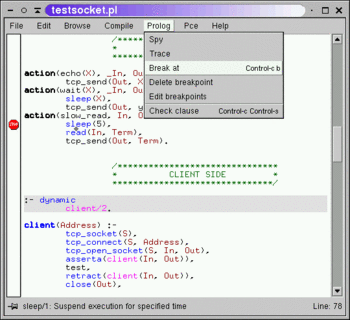SWI-Prolog
 | |
 | |
| Original author(s) | Jan Wielemaker |
|---|---|
| Developer(s) | Jan Wielemaker, Anjo Anjewierden, etc |
| Initial release | 1987 |
| Stable release | 6.2.6 / January 11, 2013 |
| Preview release | 6.3.16 / June 9, 2013 |
| Development status | Actual |
| Written in | C, Prolog |
| Operating system | Cross-platform |
| Available in | English |
| Type | Logic programming |
| License | LGPL |
| Website | swi-prolog.org/ |
SWI-Prolog is an open source implementation of the programming language Prolog, commonly used for teaching and semantic web applications. It has a rich set of features, libraries for constraint logic programming, multithreading, unit testing, GUI, interfacing to Java, ODBC and others, literate programming, a web server, SGML, RDF, RDFS, developer tools (including an IDE with a GUI debugger and GUI profiler), and extensive documentation.
SWI-Prolog runs on Unix, Windows, Macintosh and Linux platforms.
SWI-Prolog has been under continuous development since 1987. Its main author is Jan Wielemaker. The name SWI is derived from Sociaal-Wetenschappelijke Informatica ("Social Science Informatics"), the former name of the group at the University of Amsterdam, where Wielemaker is employed. The name of this group has changed to HCS (Human-Computer Studies).
User interface
SWI-Prolog is called by a command
- swipl
Initially, it expects only queries, each ended by a period. An attempt to write a program will cause an error:
?- human(john). ERROR: Undefined procedure: human/1
Here ?- is a system prompt. All the system output is shown in red color for illustration purposes.
Programs should be stored in a file and then read into the Prolog interpreter, by means of the query[1]
?-consult(file).
which can be abbreviated
?-[file].
In order to type a program interactively, the following command should be used[1]
?-consult(user).
or
?-[user].
Then everything up to the next Ctrl-D is inserted into the database.
XPCE
XPCE is a platform independent GUI toolkit for SWI-Prolog, Lisp and other interactive and dynamically typed languages. Although XPCE was designed to be language-independent, it has gained popularity most with Prolog. The development XPCE graphic toolkit started in 1987, together with SWI-Prolog.
It supports buttons, menus, sliders, tabs and other basic GUI widgets. XPCE is available for all platforms supported by SWI-Prolog.
PceEmacs
PceEmacs is a SWI-Prolog builtin editor. PceEmacs is an Emacs clone implemented in Prolog (and XPCE). It supports proper indentation, syntax highlighting, full syntax checking by calling the SWI-Prolog parser, warning for singleton variables and finding predicate definitions based on the source-information from the Prolog database.
JPL
JPL is a bidirectional interface between Java and Prolog.[2] It requires both SWI-Prolog and Java SDK.[3] It is installed as a part of SWI-Prolog.[4]